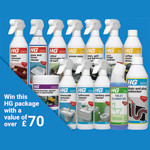UK Limescale Capitals: Where Hard Water Hits Homeowners Hardest
8 July 2025
Limescale can increase bills by £150-£300 - discover these expert tips on how to remove it
Around 60% of the UK is classed as having hard or very hard water. Specialist cleaning experts HG explain that when it comes to limescale, it's location, location, location – and some homeowners might be in for a shock. To help alleviate the issue, John Zentveld, Senior Product Specialist at HG, shares tips on how to remove stubborn limescale.
What is Hard Water?
Hard water has a high mineral content, primarily calcium and magnesium. Whilst not harmful to health, it can wreak havoc on households.
Why is Hard Water a Problem?
Hard water can cause limescale build-up in kettles, boilers, dishwashers, and washing machines, reducing their efficiency and lifespan. It also clogs pipes, reducing water pressure and can even cause leaks. For homeowners, hard water can be costly in both time and expense, leading to dry skin, difficult-to-style hair, and a constant battle in keeping kitchens and bathrooms clean.
Top 10 UK Cities with the Hardest Water
Ipswich tops the list as the UK city with the hardest water, measuring 378 parts per million (ppm). Other cities that suffer include Norwich (346 ppm), Sunderland (343 ppm), and St. Albans (342 ppm). Bury St. Edmunds, Stevenage, Basildon, Colchester, Reading, and Chelmsford also feature in the top ten, all with water hardness levels above 300 ppm. In these cities, dealing with limescale isn’t just an occasional concern – it’s an everyday reality for homeowners.
The UK Regions with the Hardest Water
London and the South East are officially the UK’s limescale hotspots, with water hardness levels exceeding 200 parts per million (ppm). In fact, 56% of HG’s limescale remover foam spray sales come from the capital, highlighting just how much of a problem hard water poses in this region.
Meanwhile, Scotland, much of Wales, and the North West enjoys softer water, with levels often below 100 ppm.
The Hidden Cost of Limescale in UK Homes
Limescale buildup is more than just an unsightly nuisance – it’s a costly problem in homes across the UK. According to British Water, even a thin 1mm layer of limescale on heating elements can drive up energy consumption by 7-10%, adding an estimated £150-£300 to annual energy bills for a typical household. This happens because limescale acts as an insulator, forcing appliances such as kettles, boilers, and washing machines to work harder and longer to reach the desired temperatures.
But the costs don’t stop at higher energy bills. Limescale shortens the lifespan of essential household appliances by clogging pipes and damaging components like heating elements, leading to costly repairs or premature replacements. Homeowners also face additional expenses on potential plumbing services if pipes become blocked.
Expert Advice on Tackling Limescale
To remove thick limescale, HG’s experts recommend using a powerful yet gentle limescale remover specifically designed to target and dissolve even the most stubborn deposits. Start by applying the product directly to the affected area and leave it to work for a few minutes – don’t scrub immediately, as this allows the solution to break down the limescale. For showerheads, taps, and other fixtures, soaking them in a mixture of hot water and limescale remover can help loosen mineral deposits. Always rinse thoroughly with clean water afterward to avoid any residue and ensure sparkling, limescale-free surfaces.
Three Little-Known Hacks for Removing Limescale
For those dealing with stubborn limescale buildup, here are three lesser-known hacks you might not have considered:
1. Cola: Cola’s acidity makes it surprisingly effective at removing limescale in toilet pans. Simply pour a generous amount of cola into the toilet and leave it overnight. Flush the next day and watch as limescale stains disappear.
2. Buttermilk: Soak a tea towel in buttermilk and lay it over areas with limescale buildup. After leaving it to work overnight, you should find the limescale wipes away with ease.
3. Fabric Softener: Fabric softener isn’t just for laundry! Mix a capful into half a bucket of warm water and use it to wipe tiles affected by limescale. Let it sit to absorb before rinsing thoroughly with hot water.
These simple solutions can help manage limescale between deep cleans and professional treatments, giving homeowners more ways to protect their appliances and surfaces.
John Zentveld, Senior Product Specialist at HG, comments:
"Many parts of the UK experience very hard water, we’ve seen firsthand how persistent limescale can pose various challenges for households. However, it is a problem that varies dramatically by region. That’s why we’ve developed several products specifically designed to tackle even the toughest limescale build-up—because a one-size-fits-all approach just doesn’t work when it comes to the many ways limescale can affect the home."
"At HG, we're passionate about helping people keep their homes running smoothly and efficiently. Our expert advice and specially formulated solutions help homeowners extend the lifespan of their appliances, cut down on energy waste, and maintain a sparkling home environment, no matter how hard their water is."

